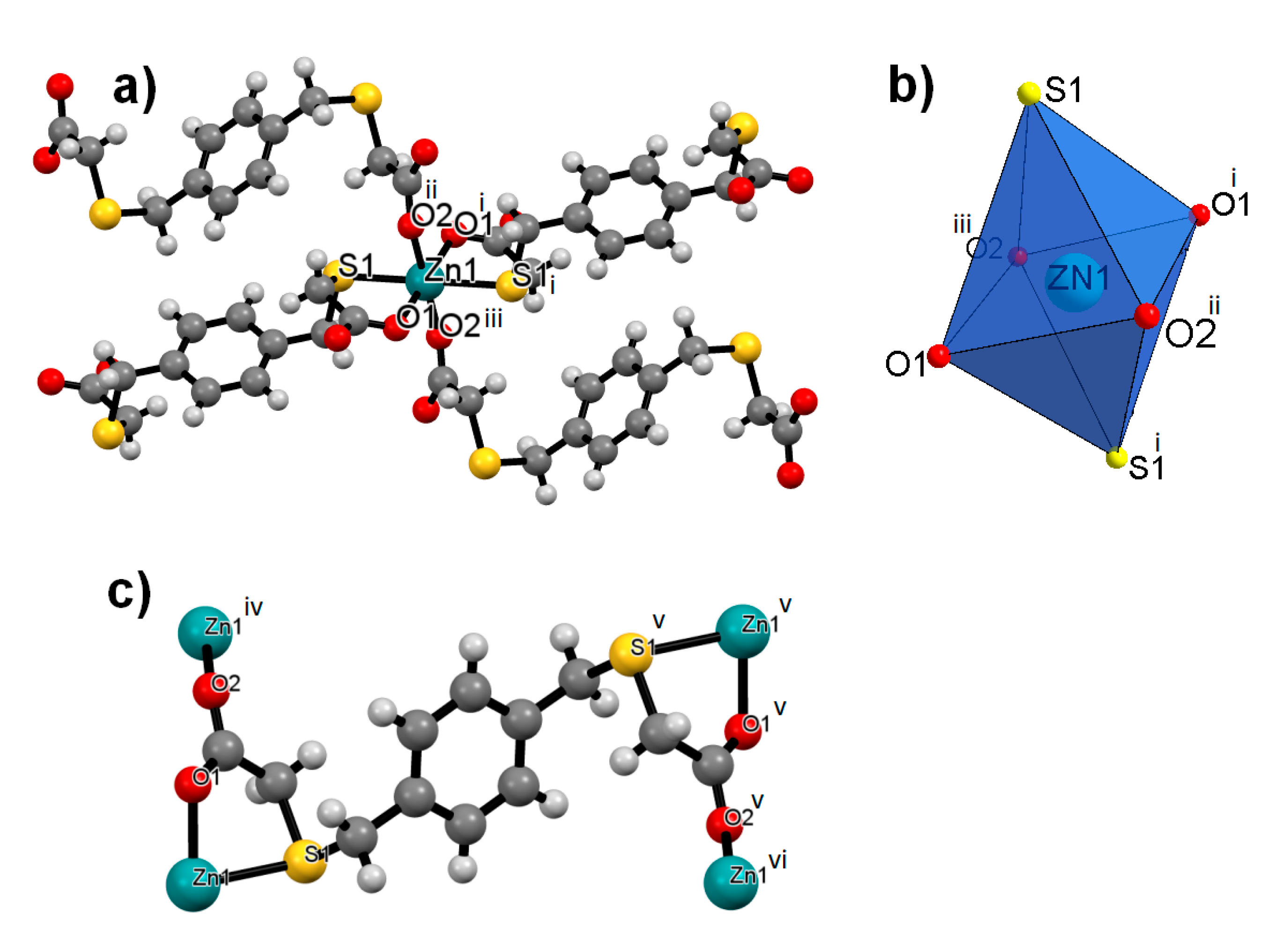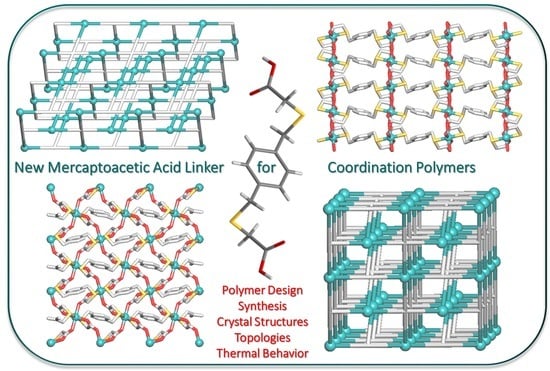Bringing a New Flexible Mercaptoacetic Acid Linker to the Design of Coordination Polymers
Abstract
:1. Introduction
2. Experimental
2.1. Materials and Methods
2.2. Precipitation Synthesis of 1P and 2P
2.3. Hydrothermal Synthesis of 1H and 2H
2.4. Single-Crystal X-ray Diffraction
3. Results and Discussion
3.1. FTIR Analysis
3.2. Crystal Structures
3.3. Powder X-ray Diffraction
3.4. Thermal Analysis
3.4.1. TG-DSC Analysis
3.4.2. TG-FTIR Analysis
4. Conclusions
Supplementary Materials
Author Contributions
Funding
Acknowledgments
Conflicts of Interest
References
- Biradha, K.; Ramanan, A.; Vittal, J.J. Coordination Polymers Versus Metal−Organic Frameworks. Cryst. Growth Des. 2009, 9, 2969–2970. [Google Scholar] [CrossRef]
- Samanidou, V.; Deliyanni, E. Metal Organic Frameworks: Synthesis and Application; MDPI AG: Basel, Switzerland, 2020. [Google Scholar]
- Kaskel, S. The Chemistry of Metal-Organic Frameworks: Synthesis, Characterization, and Applications; Wiley: Weinheim, Germany, 2016. [Google Scholar]
- Liu, T.-F.; Lü, J.; Cao, R. Coordination polymers based on flexible ditopic carboxylate or nitrogen-donor ligands. CrystEngComm 2010, 12, 660–670. [Google Scholar] [CrossRef]
- Zhang, X.; Hou, L.; Liu, B.; Cui, L.; Wang, Y.-Y.; Wu, B. Syntheses, Structures, and Luminescent Properties of Six New Zinc(II) Coordination Polymers Constructed by Flexible Tetracarboxylate and Various Pyridine Ligands. Cryst. Growth Des. 2013, 13, 3177–3187. [Google Scholar] [CrossRef]
- Ostasz, A.; Lyszczek, R.; Mazur, L.; Tarasiuk, B. Co-crystal formation between 2-amino-4,6-dimethylpyrimidine and new p-xylylene-bis(thioacetic) acid. CrystEngComm 2014, 16, 10262–10272. [Google Scholar] [CrossRef]
- Lyszczek, R.; Ostasz, A.; Bartyzel, A.; Lipke, A. Thermal, spectroscopic and luminescence investigations of lanthanide(III) coordination polymers based on V-shaped 4,4 ‘-sulfonyldibenzoic acid. J. Anal. Appl. Pyrol. 2015, 115, 370–378. [Google Scholar] [CrossRef]
- Gu, J.-Z.; Wen, M.; Liang, X.; Shi, Z.-F.; Kirillova, M.V.; Kirillov, A.M. Multifunctional Aromatic Carboxylic Acids as Versatile Building Blocks for Hydrothermal Design of Coordination Polymers. Crystals 2018, 8, 83. [Google Scholar] [CrossRef] [Green Version]
- Groom, C.R.; Bruno, I.J.; Lightfoot, M.P.; Ward, S.C. The Cambridge Structural Database. Acta Cryst. 2016, B72, 171–179. [Google Scholar] [CrossRef]
- Łyszczek, R.; Głuchowska, H.; Cristóvão, B.; Tarasiuk, B. New lanthanide biphenyl-4,4′-diacetates − hydrothermal synthesis, spectroscopic, magnetic and thermal investigations. Thermochim. Acta 2016, 645, 16–23. [Google Scholar] [CrossRef]
- Sienkiewicz-Gromiuk, J.; Rusinek, I.; Kurach, Ł.; Rzączyńska, Z. Thermal and spectroscopic (IR, XPS) properties of lanthanide(III) benzene-1,3,5-triacetate complexes. J. Therm. Anal. Calorim. 2016, 126, 327–342. [Google Scholar] [CrossRef] [Green Version]
- Lyszczek, R.; Mazur, L.; Ostasz, A.; Bartyzel, A.; Gluchowska, H. Lanthanide metal-organic frameworks: Structural, thermal and sorption properties. Adsorpt. Sci. Technol. 2017, 35, 677–683. [Google Scholar] [CrossRef]
- CrysAlis PRO; Agilent Technologies Ltd.: Yarnton, UK, 2013.
- Sheldrick, G. A short history of SHELX. Acta Crystallogr. 2008, A64, 112–122. [Google Scholar] [CrossRef] [PubMed] [Green Version]
- Farrugia, L.J. WinGX suite for small-molecule single-crystal crystallography. J. Appl. Crystallogr. 1999, 32, 837–838. [Google Scholar] [CrossRef]
- Macrae, C.F.; Edgington, P.R.; McCabe, P.; Pidcock, E.; Shields, G.P.; Taylor, R.; Towler, M.; van de Streek, J. Mercury: Visualization and analysis of crystal structures. J. Appl. Crystallogr. 2006, 39, 453–457. [Google Scholar] [CrossRef] [Green Version]
- Putz, H.; Brandenburg, K. Diamond—Crystal and Molecular Structure Visualization; Crystal Impact-GbR: Bonn, Germany, 2006. [Google Scholar]
- Blatov, V.A. Multipurpose crystallochemical analysis with the program package TOPOS. IUCr CompComm Newsl. 2006, 7, 4–38. [Google Scholar]
- Blatov, V.A.; Shevchenko, A.P.; Proserpio, D.M. Applied topological analysis of crystal structures with the program package Topospro. Cryst. Growth Des. 2014, 14, 3576–3586. [Google Scholar] [CrossRef]
- Silverstein, R.; Webster, F.; Kiemle, D.J. Spectrometric Identification of Organic Compounds, 7th ed.; John Wiley & Sons: Hoboken, NJ, USA, 2005. [Google Scholar]
- Socrates, G. Infrared and Raman Characteristic Group Frequencies: Tables and Charts; Wiley: Chichester, UK, 2004. [Google Scholar]
- Xiao, B.; Xiao, H.-Y.; Chen, M.-D. Study on the reactions of zinc carboxylate complexes with copper(II) or cobalt(II) ions. J. Coord. Chem. 2014, 67, 2455–2469. [Google Scholar] [CrossRef]
- Clegg, W.; Little, I.R.; Straughan, B.P. Zinc carboxylate complexes: Structural characterisation of some binuclear and linear trinuclear complexes. J. Chem. Soc. Dalton Trans. 1986, 1283–1288. [Google Scholar] [CrossRef]
- Stamatatos, T.C.; Katsoulakoua, E.; Nastopoulos, V.; Raptopoulou, C.P.; Manessi-Zoupa, E.; Perlepes, S.P. Cadmium Carboxylate Chemistry: Preparation, Crystal Structure, and Thermal and Spectroscopic Characterization of the One-dimensional Polymer [Cd(O2CMe)(O2CPh)(H2O)2]n. Z Naturforsch B 2003, 58, 1045–1054. [Google Scholar] [CrossRef]
- Palanisami, N.; Rajakannu, P.; Murugavel, R. Non-covalently aggregated zinc and cadmium complexes derived from substituted aromatic carboxylic acids: Synthesis, spectroscopy, and structural studies. Inorg. Chem. Commun. 2013, 405, 522–531. [Google Scholar] [CrossRef] [Green Version]
- Ye, B.-H.; Li, X.-Y.; Williams, I.D.; Chen, X.-M. Synthesis and Structural Characterization of Di- and Tetranuclear Zinc Complexes with Phenolate and Carboxylate Bridges. Correlations between 13C NMR Chemical Shifts and Carboxylate Binding Modes. Inorg. Chem. 2002, 41, 6426–6431. [Google Scholar] [CrossRef]
- Vaz, J.L.L.; Duc, G.; Petit-Ramel, M.; Faure, R.; Vittori, O. Cd(II) complexes with phthalic acids: Solution study and crystal structure of cadmium(II) phthalate hydrate. Can. J. Chem. 1996, 74, 359–364. [Google Scholar] [CrossRef] [Green Version]
- Materazzi, S. Thermogravimetry—Infrared Spectroscopy (TG-FTIR) Coupled Analysis. Appl. Spectrosc. Rev. 1997, 32, 385–404. [Google Scholar] [CrossRef]
- Risoluti, R.; Fabiano, M.A.; Gullifa, G.; Ciprioti, S.V.; Materazzi, S. FTIR-evolved gas analysis in recent thermoanalytical investigations. Appl. Spectrosc. Rev. 2017, 52, 39–72. [Google Scholar] [CrossRef]
- Gao, N.; Li, A.; Quan, C.; Du, L.; Duan, Y. TG–FTIR and Py–GC/MS analysis on pyrolysis and combustion of pine sawdust. J. Anal. Appl. Pyrolysis 2013, 100, 26–32. [Google Scholar] [CrossRef]
- Meng, A.; Zhou, H.; Qin, L.; Zhang, Y.; Li, Q. Quantitative and kinetic TG-FTIR investigation on three kinds of biomass pyrolysis. J. Anal. Appl. Pyrolysis 2013, 104, 28–37. [Google Scholar] [CrossRef]
- Łyszczek, R.; Bartyzel, A.; Głuchowska, H.; Mazur, L.; Sztanke, M.; Sztanke, K. Thermal investigations of biologically important fused azaisocytosine-containing congeners and the crystal structure of one representative. J. Anal. Appl. Pyrolysis 2018, 135, 141–151. [Google Scholar] [CrossRef]
- Thermo Scientific™ Inc. OMNIC™ Specta Software; Thermo Scientific™ Inc.: Waltham, MA, USA, 2013. [Google Scholar]
- Kirillov, A.M.; Coelho, J.A.; Kirillova, M.V.; da Silva, M.F.C.G.; Nesterov, D.S.; Gruenwald, K.R.; Haukka, M.; Pombeiro, A.J. Bringing an “old” biological buffer to coordination chemistry: New 1D and 3D coordination polymers with [Cu4(Hbes)4] cores for mild hydrocarboxylation of alkanes. Inorg. Chem. 2010, 49, 6390–6392. [Google Scholar] [CrossRef]
- Kirillova, M.V.; Kirillov, A.M.; Martins, A.N.; Graiff, C.; Tiripicchio, A.; Pombeiro, A.J. Topologically unique heterometallic CuII/Li coordination polymers self-assembled from N,N-bis(2-Hydroxyethyl)-2-aminoethanesulfonic acid biobuffer: Versatile catalyst precursors for mild hydrocarboxylation of alkanes to carboxylic acids. Inorg. Chem. 2012, 51, 5224–5234. [Google Scholar] [CrossRef]
- Kirillov, A.M.; Karabach, Y.Y.; Kirillova, M.V.; Haukka, M.; Pombeiro, A.J.L. Topologically unique 2D heterometallic CuII/Mg coordination polymer: Synthesis, structural features, and catalytic use in alkane hydrocarboxylation. Cryst. Growth Des. 2012, 12, 1069–1074. [Google Scholar] [CrossRef]
- Dias, S.S.P.; Kirillova, M.V.; André, V.; Kłak, J.; Kirillov, A.M. New tricopper(II) cores self-assembled from aminoalcohol biobuffers and homophthalic acid: Synthesis, structural and topological features, magnetic properties and mild catalytic oxidation of cyclic and linear C5–C8 alkanes. Inorg. Chem. Front. 2015, 2, 525–537. [Google Scholar] [CrossRef]
- Gu, J.Z.; Wen, M.; Cai, Y.; Shi, Z.; Nesterov, D.S.; Kirillova, M.V.; Kirillov, A.M. Cobalt(II) Coordination Polymers Assembled from Unexplored Pyridine-Carboxylic Acids: Structural Diversity and Catalytic Oxidation of Alcohols. Inorg. Chem. 2019, 58, 5875–5885. [Google Scholar] [CrossRef] [PubMed]
- Morsali, A.; Hashemi, L. Main Group Metal Coordination Polymers: Structures and Nanostructures; John Wiley & Sons: Hoboken, NJ, USA, 2017. [Google Scholar]
- MacGillivray, L.R.; Lukehart, C.M. (Eds.) Metal-Organic Framework Materials; John Wiley & Sons: Hoboken, NJ, USA, 2014. [Google Scholar]








| Compound | [Zn(p-XBT)]n (1H) | [Cd(p-XBT)]n (2H) |
|---|---|---|
| Chemical formula | C12H12O4S2Zn | C12H12O4S2Cd |
| Formula weight | 349.71 | 396.74 |
| Crystal system | monoclinic | monoclinic |
| Space group | P21/c | P21/c |
| a (Å) | 9.4845(6) | 8.9996(5) |
| b (Å) | 8.3523(8) | 8.5045(11) |
| c (Å) | 7.9804(4) | 8.6568(6) |
| β (°) | 90.502(5) | 90.454(6) |
| V (Å3) | 632.16(8) | 662.55(10) |
| Z | 2 | 2 |
| T (K) | 100(2) | 100(2) |
| Color and shape | colorless plate | colorless plate |
| Dcalc (g cm−3) | 1.837 | 1.989 |
| μ (mm−1) | 2.278 | 1.968 |
| Refl. collected | 2546 | 2795 |
| Refl. unique | 1444 | 1507 |
| R(int) | 0.0281 | 0.0285 |
| Refl. obs. (I > 2σ(I)) | 1259 | 1253 |
| Refined parameters | 112 | 112 |
| GooF on F2 | 0.995 | 0.973 |
| R1 (I > 2σ(I)) | 0.0288 | 0.0272 |
| wR2 (all data) | 0.0705 | 0.0625 |
© 2020 by the authors. Licensee MDPI, Basel, Switzerland. This article is an open access article distributed under the terms and conditions of the Creative Commons Attribution (CC BY) license (http://creativecommons.org/licenses/by/4.0/).
Share and Cite
Ostasz, A.; Kirillov, A.M. Bringing a New Flexible Mercaptoacetic Acid Linker to the Design of Coordination Polymers. Polymers 2020, 12, 1329. https://doi.org/10.3390/polym12061329
Ostasz A, Kirillov AM. Bringing a New Flexible Mercaptoacetic Acid Linker to the Design of Coordination Polymers. Polymers. 2020; 12(6):1329. https://doi.org/10.3390/polym12061329
Chicago/Turabian StyleOstasz, Agnieszka, and Alexander M. Kirillov. 2020. "Bringing a New Flexible Mercaptoacetic Acid Linker to the Design of Coordination Polymers" Polymers 12, no. 6: 1329. https://doi.org/10.3390/polym12061329






